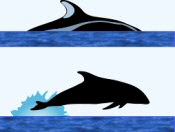CLASS: Mammalia
ORDER: Cetacea
SUBORDER: Odontoceti
FAMILY: Delphinidae
GENUS: Lagenorhynchus
SPECIES: obliquidens
White-sided dolphins come in two forms: the Atlantic white-sided and the Pacific white-sided. Somewhat similar in appearance, the Atlantic species is larger and more robust than its Pacific counterpart. Both species are avid bow-riders and acrobatic jumpers. C.M. Scammon reported in 1874, "They are seen in numbers varying from a dozen to many hundreds, tumbling over the surface of the sea, or making arching leaps, plunging again on the same curve, or darting high and falling diagonally sideways upon the water... accompanied by a report that may be heard at some distance."
Physical Description
Often referred to as "lag" because of its cumbersome scientific name. Lagenorhynchus, the Pacific white-sided dolphin has a short, rounded, thick beak containing 23 to 32 small, rounded slightly curved teeth in each side of the upper and lower jaws. This dolphin is energetic and quite active and is frequently seen leaping, belly flopping, and somersaulting. It is a strong, fast swimmer and enthusiastic bow rider, often staying with moving vessels for extended periods.

Surface Characteristics
Color
The Pacific white-sided dolphin is attractively marked. Its back is black and its sides are light gray with thin, white stripes that extend from above the eye along the sides, widening towards the tail; its belly is white. It has a black beak and lips and a black ring around each eye.
Fins and Fluke
Its dorsal fin is tall and sharply hooked, and is located at the center of the back. The leading edge is black and the rear portion is light gray. Its flippers are small and curved and rounded at the tips. Its flukes are notched in the center.
Length and Weight
These dolphins reach a length of 7 to 8 feet (2.1 to 2.4 m) and weigh 300 pounds (150 kg).
Feeding
Lags eat squid and small schooling fish such as anchovies, herring, sardines, and hake. It is believed they feed largely at night.
Mating and Breeding
Sexual maturity for both sexes is reached when they are 6 feet in length (1.8 m), but this can vary according to geographical location. Length at birth is 31 to 37 inches (80 to 95 cm); gestation period is estimated to be 9 to 12 months.

Range Map
Distribution and Migration
The Pacific white-sided dolphin inhabits temperate, coastal waters in the North Pacific, avoiding both tropical or Arctic waters. Its range extends from Amchitka Island in the Aleutians, to the Gulf of Alaska south along the coast of North America to the tip of Baja California. It is also found off the coast of Asia from the Kuril Islands to Japan. It is abundant in Japanese waters with estimates of 30,000 to 50,000 in that area.
Natural History
Pacific white-sided dolphins are often found in large herds of 90 to 100. The herds are made up of animals of both sexes and all ages. Since they share the same range, they are most commonly seen with northern right-whale dolphins and are often seen accompanying other dolphins and large whales. They are considered residents in some parts of their range, notably Monterey Bay and off southern California and northwestern Baja California. These resident populations are joined by transient groups from other areas from fall to spring.
Status
This species is no longer commercially hunted in the United States. Some are taken for food in Japan's coastal fishery. They are difficult to catch, however, and the numbers taken are not a threat to the total population in Japanese waters. A few have been captured for display in aquariums, and unknown numbers have been accidentally killed in drift and gill nets. Population figures are unknown.
Bibliography
- Jefferson, T.A., M.A. Webber, R.L. Pitman. 2015. Marine Mammals of the World: A Comprehensive Guide to their Identification, 2nd edition. Elsevier/AP.
- Leatherwood, S., R. Reeves, W. Perrin and W. Evans Whales, Dolphins and Porpoises of the Eastern North Pacific and Adjacent Arctic Waters. U.S. Dept. of Commerce: NOAA Technical Report. NMFS Circular 444, July 1982
- Leatherwood, S.L. and R.R. Reeves. 1983. The Sierra Club Handbook of Whales and Dolphins. Sierra Club Books, San Francisco.
Acknowledgements
Illustrations courtesy Uko Gorter, copyright ©2017 all rights reserved.
FACT SHEETS MAY BE REPRINTED FOR EDUCATIONAL OR SCIENTIFIC PURPOSES



